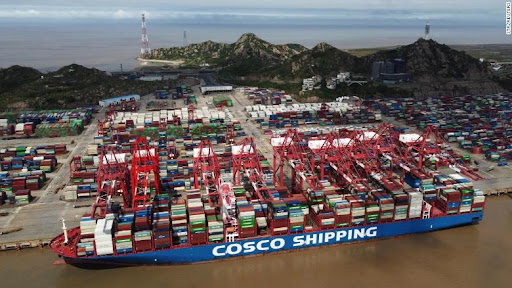
23/05/2022
U&I Logistics - Congestion levels at ports is expected to return and may last for the foreseeable future. The main reason is due to severe lockdowns in China, Shanghai - the world's biggest container port is seriously affected, causing problems at other ports across the continent.
Continuing to order lockdowns, China's transport crisis spreads
According to data analysis, when Shanghai was shut down by China, delays in shipment between China and major US and European ports have quadrupled since the end of March.
The time it takes for ships to leave China to arrive at major ports around the world has steadily increased over the past year, but there have been some signs of relief since December. Specifically in January and February, transit times between Shanghai and Long Beach has decreased significantly. Since March, however, transit times on that route have increased sharply again.
After that, many truck drivers struggled to pick up containers at ports in China. The main reason is due to travel restrictions and Covid testing requirements. In a advisory last month, shipping giant Maersk warned that trucking services in Shanghai would be severely affected by the restrictions mentioned above.

Josh Brazil, director of Supply Chain Data Insights, said: “The shutdown of the manufacturing industry and the inability to move trucks quickly has reduced the exports, increasing the delay of shipments”.
Delays will continue into the upcoming summer months, he added, as factories struggle to return to normal operations in Shanghai.
Although authorities have allowed some businesses to restart production, many workers are still stuck in quarantine at home. Factories that have been allowed to reopen are facing shortages of components and are having trouble securing trucks to get in and out of ports.
“Ripples in shipment delays are just beginning to be visible and are expected to extend well into the next few months,” said Josh Brazil.
Shanghai Port remained open throughout the city's lockdown, but data from various shipping firms shows an increasing backlog of ships and containers.
US supply chain companies have expressed concern about fresh chaos heading towards US ports, which are still recovering from the severe congestion and delays their countries suffered last year. .
While there has been "a temporary relief" at US ports late last month, things may get "a lot worse" this summer because of what's happening in China, said Shelley Simpson, chief commercial director of JB Hunt Transport Services.
Ships and containers jam at ports
Cargo waiting to be shipped is getting worse in China and other parts of the world, with nearly 20% of container vessels globally now waiting outside congested ports, including more than 412 ships, up 58% since February (according to a survey published by Windward). The shutdowns in China have indeed caused a bottleneck.
President Xi Jinping this week signaled that China will continue with a zero-tolerance approach to Covid.
According to most recent data from S&P Global Market Intelligence, the number of vessels waiting at the port of Shanghai rose to 384 as of April 25, up 27% from a month earlier.
Containers are also piling up because of truck shortages.
.jpg)
Global inflation soars
According to Daejin Lee - associate director at S&P Global Market Intelligence, the tense situation in Shanghai will push global inflation higher this year. He further pointed out that last year's inflation was driven by two factors - shortages of key parts due to supply chain bottlenecks and record-high container freight rates.
"Another lengthy delay in seaborne supply of key parts by sea due to China's port congestion could increase consumer prices much faster than previously expected”, Mr. Lee added.
Shipping firm Maersk said that freight rates will continue to increase as the pressure of the supply chain persists. According to the company, congestion in sectors such as trucking and warehousing in China has created "bottlenecks", leading to challenging supply chain management services.
U&I Logistics